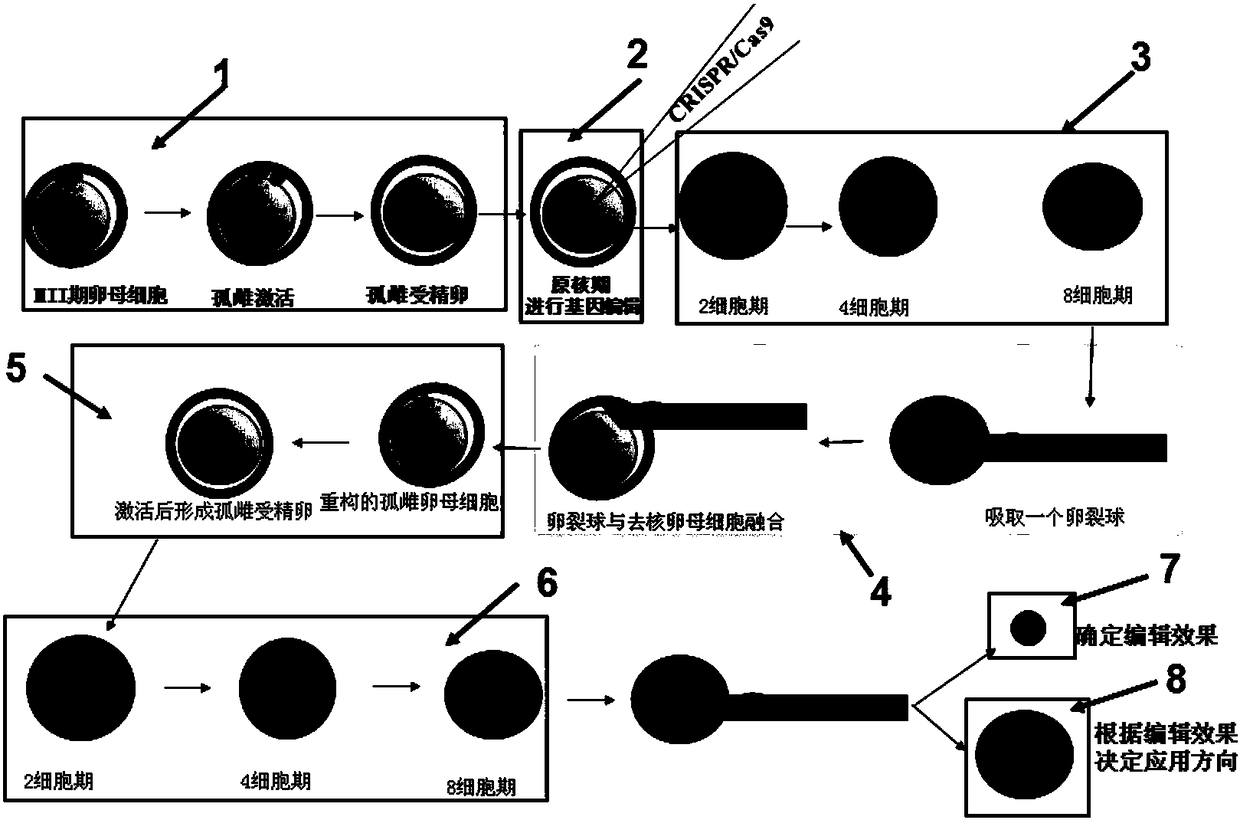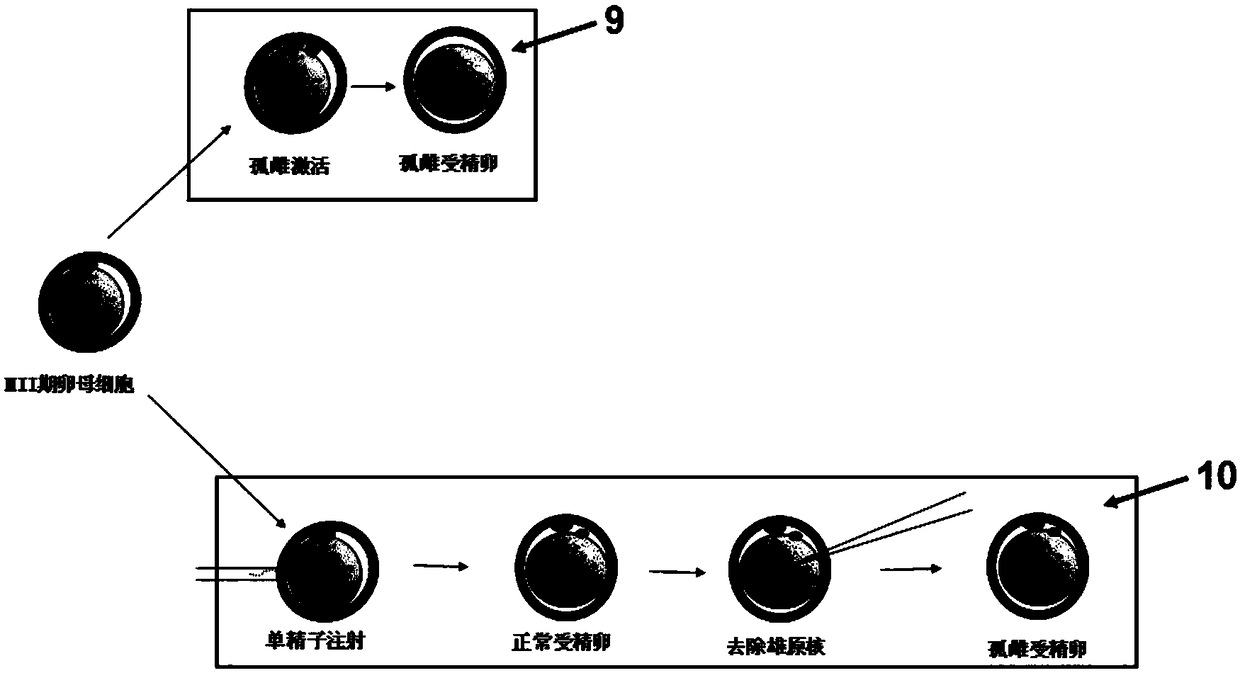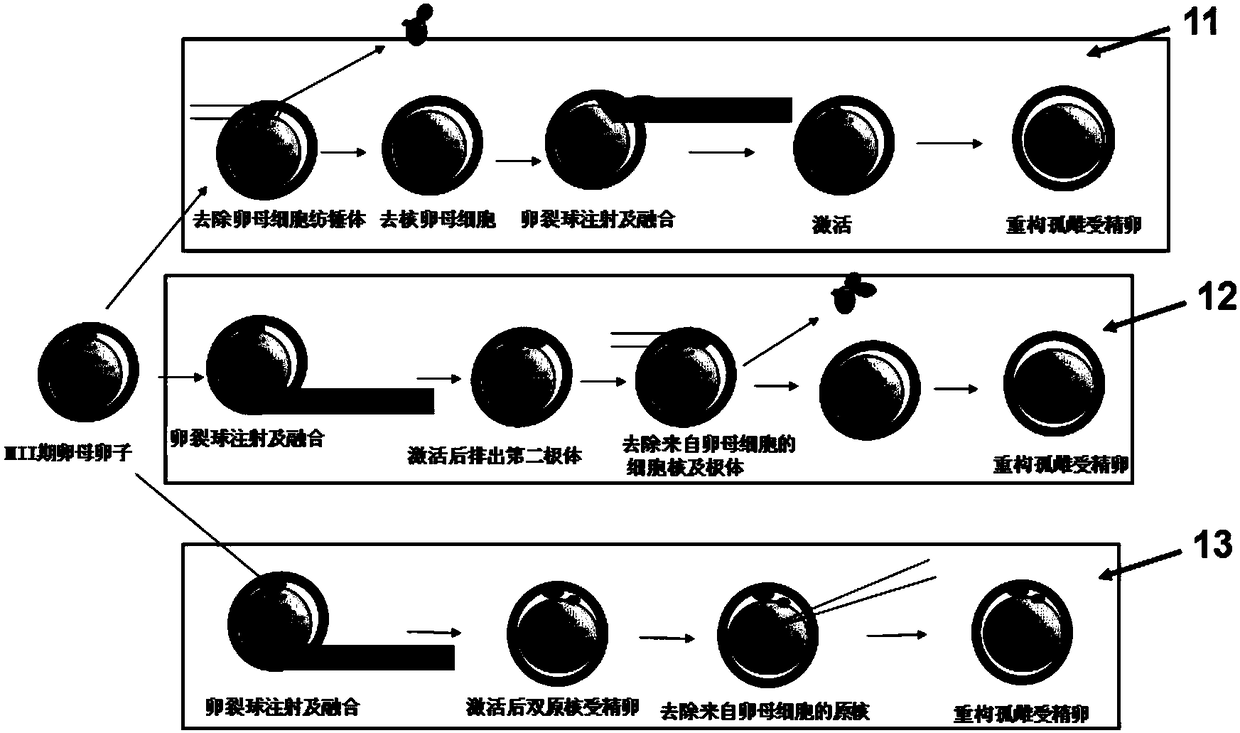Editing method aiming to female genes
A gene editing and editing technology, which is applied to other methods of inserting foreign genetic materials, genetic engineering, plant gene improvement, etc., can solve the problems of editing failure, loss of use value of cells, and inability to predict which cells, etc., to facilitate transformation, Ensure the effect of the effect
- Summary
- Abstract
- Description
- Claims
- Application Information
AI Technical Summary
Problems solved by technology
Method used
Image
Examples
Embodiment 1
[0052] 1. Acquisition of parthenogenetic fertilized eggs: Mouse MII stage oocytes are parthenogenetically activated with calcium ionophore A23187 combined with puromycin to form parthenogenetic fertilization containing only female chromosomes (ie, haploid parthenogenetic chromosomes) eggs (see figure 1 1 and figure 2 Middle 9).
[0053] 2. Parthenogenetic zygote gene editing: use CRISPR / Cas9 gene editing technology to edit the target gene of the parthenogenetic zygote obtained in step 1 at the pronuclear stage (see figure 1 Medium 2).
[0054] 3. Isolation of blastomeres from edited parthenogenetic embryos: The edited parthenogenetic zygotes obtained in step 2 were further subjected to embryo culture until the 8-cell stage (see figure 1 Middle 3). Aspirate one blastomere from the embryo with a 30 µm inner diameter embryo biopsy needle (see figure 1 Middle 4).
[0055] 4. Reconstruct the parthenogenetic embryo: remove the spindle body of the mouse MII stage oocyte (includi...
Embodiment 2
[0059] 1. Acquisition of parthenogenetic fertilized eggs: Inject the mouse MII stage oocytes with mouse single sperm to activate fertilization. After the double pronuclei appear (pronuclear stage), the male pronuclei are removed and the female pronuclei are retained, and finally a single pronucleus is formed. A parthenogenetic zygote containing female chromosomes (see figure 1 1 and figure 2 Medium 10).
[0060] 2. Parthenogenetic zygote gene editing: use CRISPR / Cas9 gene editing technology to edit the target gene of the parthenogenetic zygote obtained in step 1 at the pronuclear stage (see figure 1 Medium 2).
[0061] 3. Isolation of blastomeres from edited parthenogenetic embryos: The edited parthenogenetic zygotes obtained in step 2 were further subjected to embryo culture until the 8-cell stage (see figure 1 Middle 3). Aspirate one blastomere from the embryo with a 30 µm inner diameter embryo biopsy needle (see figure 1 Middle 4).
[0062] 4. Reconstruct the parthen...
Embodiment 3
[0066] 1. Acquisition of parthenogenetic zygotes: Mouse MII stage oocytes were parthenogenetically activated using calcium ionophore A23187 combined with puromycin to form parthenogenetic zygotes containing only female chromosomes (see figure 1 1 and figure 2 Middle 9).
[0067] 2. Parthenogenetic zygote gene editing: use CRISPR / Cas9 gene editing technology to edit the target gene of the parthenogenetic zygote obtained in step 1 at the pronuclear stage (see figure 1 Medium 2).
[0068] 3. Isolation of blastomeres from edited parthenogenetic embryos: The edited parthenogenetic zygotes obtained in step 2 were further subjected to embryo culture until the 8-cell stage (see figure 1 Middle 3). Aspirate one blastomere from the embryo with a 30 µm inner diameter embryo biopsy needle (see figure 1 Middle 4).
[0069] 4. Reconstruction of parthenogenetic embryos: Inject the blastomeres drawn in step 3 into the perivitelline space of mouse MII stage oocytes, activate and fertiliz...
PUM
 Login to View More
Login to View More Abstract
Description
Claims
Application Information
 Login to View More
Login to View More - R&D
- Intellectual Property
- Life Sciences
- Materials
- Tech Scout
- Unparalleled Data Quality
- Higher Quality Content
- 60% Fewer Hallucinations
Browse by: Latest US Patents, China's latest patents, Technical Efficacy Thesaurus, Application Domain, Technology Topic, Popular Technical Reports.
© 2025 PatSnap. All rights reserved.Legal|Privacy policy|Modern Slavery Act Transparency Statement|Sitemap|About US| Contact US: help@patsnap.com



